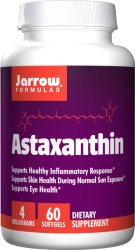$11.28
$10.44
(SAVE Now!)
as of 04/18/2024 (Details)
View larger Product Profile Astaxanthin is a reddish-orange carotenoid and xanthophyll pigment common in the natural environment. Many animals derive their distinctive coloring from astaxanthin - salmon, shrimp, krill, lobster, and flamingoes. Animals cannot make carotenoids, so they must obtain them from plants, bacteria, and algae. That many forms of life retain and concentrate astaxanthin in their tissues suggests it is somehow useful. In plants, it assists in photosynthesis and offers protection from oxygen and light in all organisms. For example, it is believed that astaxanthin in salmon eggs (hence their orange color) helps to protect them from the sun’s UV radiation before they hatch. Astaxanthin has been found to be a powerful antioxidant possessing upwards of 100 times and 10 times greater capacity to neutralize reactive oxygen species (ROS) than vitamin E and beta-carotene, respectively. Like most carotenoids, astaxanthin cannot be converted into vitamin A. It is believed that the strong antioxidant and inflammation-modulating properties of astaxanthin are at the root of its clinically observed effects on skin, eye, and joint health.* Distinguishing Features: Promotes a healthy inflammatory response*Supports skin during sun exposure*Supports joint and eye health* View larger The Eyes Have It Although lutein is probably more recognizable as an eye-carotenoid since it has long been known to concentrate in the macula, it is now understood that astaxanthin will also accumulate in the retina of mammals. There it likely acts similarly to lutein and zeaxanthin in warding-off oxidative assaults that commonly lead to the formation of advanced glycation end products (AGEs).* For instance, the retinal photoreceptors of rats fed astaxanthin were better protected from UV-light injury than those not fed astaxanthin.* Clinically, astaxanthin has also demonstrated effects on eye accommodation and increased blood flow in humans.* Accommodation relates to the eyes ability to bend the lens to bring the visual field into focus. Accommodation ability tends to decrease as we age because the lens becomes less pliable as it accumulates oxidative damage to its constituent proteins. The muscles that flex the lens in the eye can also become fatigued after long use, leading to eye strain and loss of acuity. Seemingly by increasing blood flow and protecting ocular tissue, astaxanthin can have both short and long term protective effects on the eyes.* Grade A-xanthin For Skin Much like in salmon eggs, astaxanthin seems to protect human skin from harmful UV-induced oxidative stress and hence damage.* An in vitro study, using human skin cells, has shown that preincubation with astaxanthin prevents ultraviolet A (UVA)-induced decreases in cellular superoxide dismutase (SOD) activity and cellular glutathione content, which are the skin’s natural protectants. Via this protection, astaxanthin also seems to dampen the skin’s inflammatory response to the sun and support collagen levels.* In fact, astaxanthin seems to modulate levels of inflammatory mediators in the body like nuclear factor kappaB (NF-κB), TNF-α, and interleukin-1 beta (IL-1β).* Since an out-of-balance inflammatory cascade can be an enemy to healthy skin, it should not come as a surprise that astaxanthin supplementation appears to help maintain healthier, smoother, and lighter looking skin.* *These statements have not been evaluated by the Food and Drug Administration. This product is not intended to diagnose, treat, cure, or prevent any disease.
Technical Details
- Promotes a healthy inflammatory response
- Supports skin during sun exposure
- Supports joint health and eye health
